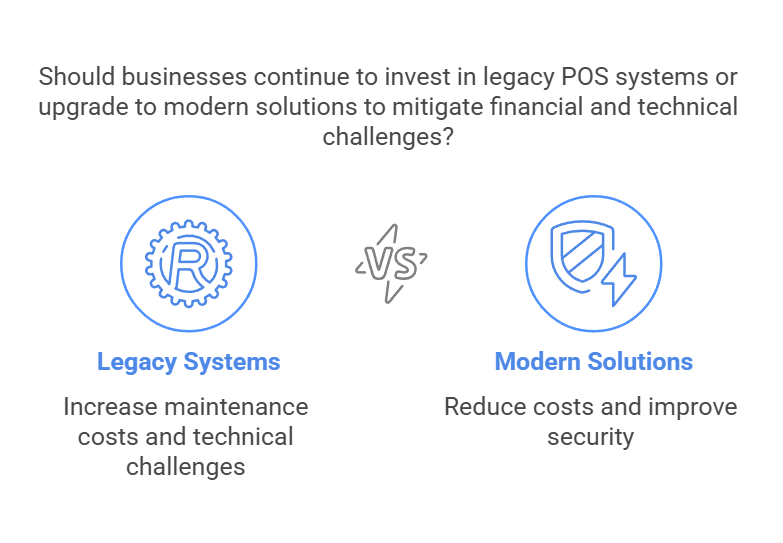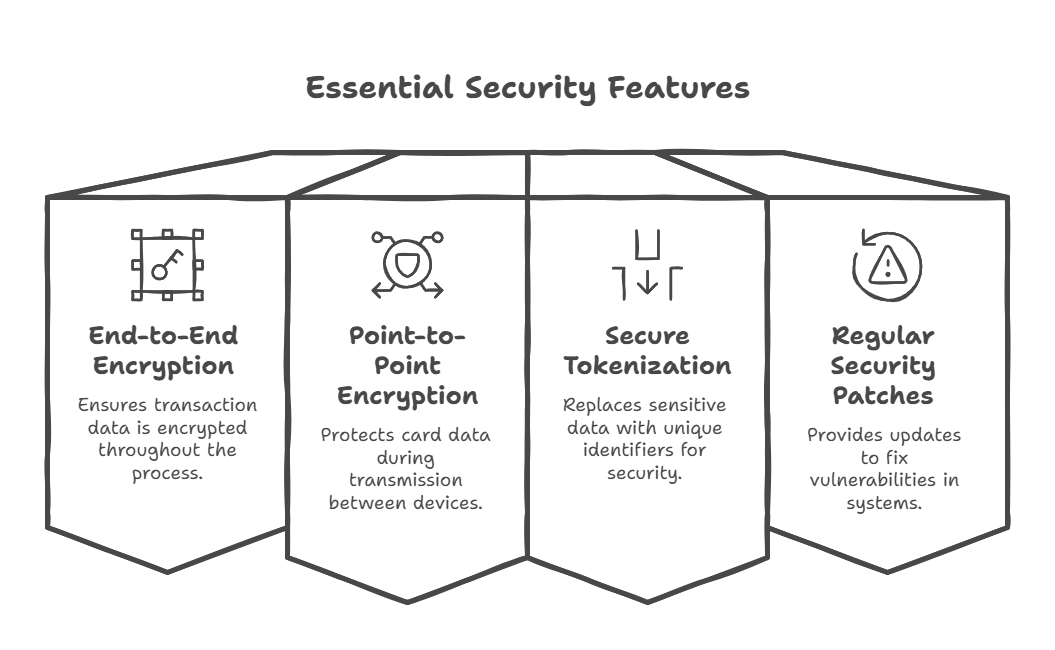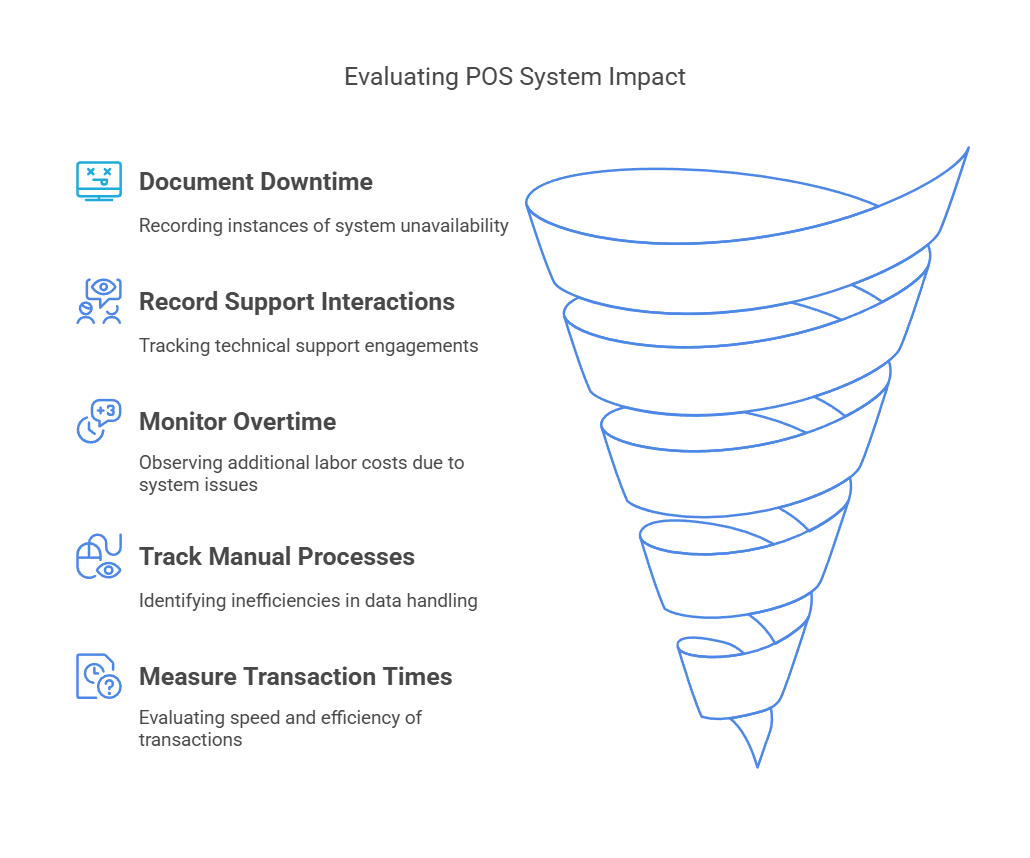
The Hidden Costs of Outdated Point of Sales Systems: What Operations Managers Need to Know
5 minute read
The Hidden Costs of Outdated Point of Sales Systems: What Operations Managers Need to Know
Article at a Glance:
- Legacy POS systems create compounding challenges including rising maintenance costs, security vulnerabilities, and operational bottlenecks that impact daily business operations
- Security and compliance risks increase as older systems struggle to maintain current protection standards and meet evolving industry requirements
- Integration limitations prevent seamless data flow between systems, hindering inventory management, customer relationships, and business intelligence
- Staff productivity suffers from complex interfaces, manual workarounds, and increased training requirements
- Strategic limitations affect business growth by restricting payment options, loyalty programs, and the ability to adapt to changing customer expectations
Understanding the full impact of aging Point of Sales Systems helps operations managers make informed decisions about system modernization while balancing current operational needs with future growth requirements.
For operations managers overseeing multi-location retail or hospitality businesses, point of sales systems age is a critical consideration. Industry standards generally consider POS systems outdated when they reach 5-7 years of age, primarily due to rapid technological advancements and evolving security requirements.
While basic costs like licensing fees, maintenance contracts, and hardware expenses are visible, the true cost impact of maintaining older point of sales systems extends far beyond these apparent expenses.
Understanding the Financial Impact of Legacy Systems

The financial burden of maintaining older point of sales systems compounds over time. As systems age, businesses typically face increasing maintenance costs due to several factors: the growing scarcity of compatible replacement parts, the need for specialized technical expertise for legacy systems, and the complexity of maintaining outdated software platforms.
A particularly significant concern is the software aspect of legacy systems. Many older POS systems operate on outdated operating systems that no longer receive regular security updates. This creates a cascade of technical challenges, forcing businesses to develop workarounds and implement manual processes to bridge growing capability gaps.
Key Operational Impacts
Transaction Processing Challenges:
- System slowdowns during peak business hours create customer bottlenecks
- Older systems typically require more frequent reboots and maintenance
- Limited payment options may restrict customer payment preferences
Staff Productivity Issues:
- New employees typically require extended training time to learn complex legacy interfaces
- Manual workarounds and system limitations can increase transaction error rates
- Staff often spend additional time on manual data entry and reconciliation tasks
Security and Compliance Considerations

The high cost of data breaches, with the global average reaching $4.45 million according to IBM’s 2023 Cost of Data Breach Report, underscores the importance of robust security. Retailers, in particular, handle sensitive customer data and can be vulnerable through various points, including potentially outdated point of sales systems.
The Payment Card Industry Data Security Standard (PCI DSS) requirements continue to evolve, creating compliance challenges for businesses operating older systems.
Essential Security Features Often Lacking in Outdated POS Systems:
- End-to-end encryption for transaction data
- Point-to-point encryption for card data
- Secure tokenization capabilities
- Regular security patch support
The Innovation and Integration Challenge
Modern retail operations require seamless data flow between systems. Legacy POS systems often create significant barriers to this integration, affecting everything from inventory management to customer relationship management. Without real-time data synchronization, businesses must rely on manual processes and delayed reporting, which can impact operational decision-making.
Integration Limitations Commonly Affect:
Data Management:
- Manual data entry requirements across multiple systems
- Delayed access to business intelligence
- Limited reporting capabilities for performance analysis
Customer Experience:
- Restricted ability to implement modern loyalty programs
- Limited support for contemporary payment methods
- Reduced capability for personalized customer interactions
Strategic Impact on Business Growth
Operating with outdated point of sales systems creates strategic disadvantages that affect both current operations and future growth potential. As consumer expectations for seamless transactions and diverse payment options continue to rise, businesses must evaluate whether their existing POS infrastructure can support these evolving needs.
Key Impact Areas:
Market Adaptability:
- Limited ability to implement new service offerings
- Restricted capacity to adapt to changing customer preferences
- Reduced flexibility in pricing and promotion strategies
Operational Efficiency:
- Increased manual workload for staff
- Higher likelihood of inventory discrepancies
- Extended time required for system maintenance and updates
Assessing Your Current System: A Practical Framework

To evaluate your current POS system’s true cost impact, consider implementing this structured assessment approach:
Direct Cost Analysis (Track over 3 months)
- Document frequency and duration of system downtime
- Record all technical support interactions and associated costs
- Monitor staff overtime related to system limitations
- Track time spent on manual data entry and reconciliation
Performance Impact Assessment
- Measure average transaction completion times
- Monitor customer wait times during peak periods
- Track error rates in daily transactions
- Document customer feedback related to payment processing
Planning for Modernization
When considering a point of sales systems upgrade, focus on creating a comprehensive transition plan that minimizes operational disruption. Begin by documenting your current system’s limitations and defining clear objectives for the new system. This groundwork helps ensure your modernization project addresses both immediate challenges and long-term strategic needs.
Essential Planning Considerations:
Business Continuity Elements:
- Detailed data migration strategy
- Staff training requirements and timeline
- Customer communication plan
- Rollback procedures for unexpected issues
Risk Mitigation Strategies:
- Phased implementation approach
- Comprehensive testing protocols
- Dedicated support team during transition
- Clear success metrics and monitoring plan
Frequently Asked Questions
Q: How do maintenance costs typically compare between legacy and modern POS systems?
A: While legacy systems often have lower upfront costs, they typically incur higher maintenance expenses over time due to specialized support requirements and increasing hardware replacement costs. Modern systems generally offer more predictable monthly costs that include regular updates and support.
Q: What are the common integration challenges with outdated POS systems?
A: Legacy systems often struggle with modern API integration, real-time data synchronization, and current security protocols. These limitations frequently necessitate manual processes or custom workarounds that increase operational costs.
Q: How does an outdated POS system impact employee productivity?
A: Older systems typically require more extensive training time for new employees and often necessitate manual workarounds for modern business requirements. This can lead to increased processing time for transactions and higher rates of human error.
Frequently Unasked Questions
Q: How does POS system age affect customer retention?
A: While direct correlation data is limited, outdated POS systems can impact customer experience through longer wait times, limited payment options, and inconsistent experiences across locations.
Q: What hidden training costs emerge from maintaining legacy systems?
A: Beyond initial training, organizations often face ongoing costs from developing and documenting workarounds, maintaining specialized knowledge, and increased training time for new staff.
Q: How do outdated POS systems impact supply chain efficiency?
A: Limited integration capabilities often create delays in inventory updates and order processing. These delays can affect stock management and supplier communications, potentially leading to inventory inconsistencies.
Take Your Restaurant’s Efficiency to the Next Level with Adora POS!
Running a fast-paced restaurant, bar, or pizzeria requires a seamless and efficient point-of-sale system. Adora POS is designed to simplify operations, speed up order entry, and ensure accurate transactions—all while giving you full control with remote management access.
Want to see how Adora POS can transform your business? Schedule a demo today and experience the difference firsthand! Our 24/7 personalized support and fully integrated features will keep your restaurant running smoothly.
 Schedule Your Demo Now
Schedule Your Demo Now
Stay connected with us for industry insights and updates!






